Decades of Fashion Harriet Worsley Torrent
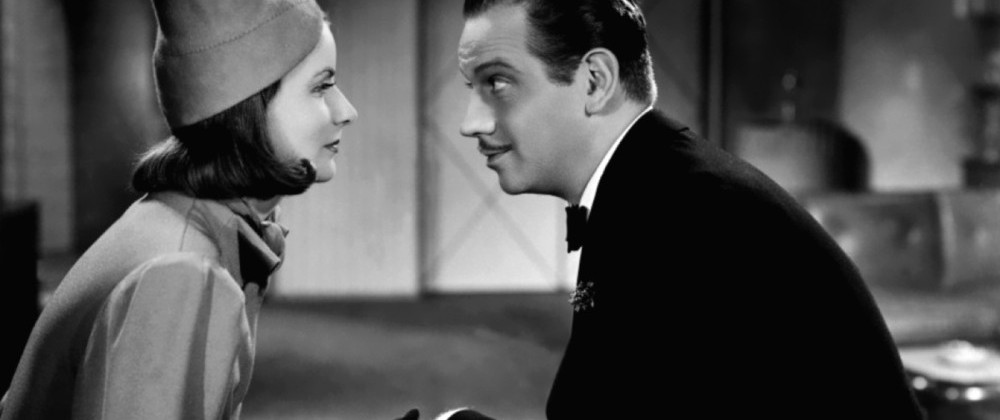
Star equally Auteur
The mystique that all the same attaches to Greta Garbo is crystallised in the lists of Greatest Movie Stars of All Time that appear on a regular basis – in a Premiere mag listing in the year of her centenary, she ranked number eight. Her enduring appeal summed upward thus: "her metier was playing someone unknowable, someone mostly tragic." [1] For the American Film Institute's list of Greatest Female Legends, she appears a little higher, at number 5. Jeanine Basinger places her in the category of 'Unreal Stars,' along with Hedy Lamarr, Rita Hayworth and Marilyn Monroe. [two] Many years ago, Lewis Jacobs summed her upward as "the ultra-sophisticated, neurotic adult female of the earth who lives simply for love." And yet she could portray the devoted mother in a film such every bit The Single Standard (John Southward. Robertson, 1929) but it was not to this grapheme blazon that the audience responded with such ferocity: "she was simply too extraordinary to be remembered with a cold compress in her hand." [iii] Is she, as Alexander Walker has claimed, "the purest art-object the product organisation of her time has left us"? [4] Or – was she its greatest victim?
Charles Affron defines Garbo's art as one of reflection equally opposed to action. The star is, after all, a reflection of the audience – we create them and they exist only for us. (Or so we choose to believe.) The greatest role Garbo ever played was perhaps Garbo the Icon, a figure she consciously manufactured. Her mythological significance, as Roland Barthes and then eloquently describes it, lies in the fragile intellectual geometry of her mask-like, deified "snowy, solitary face"; a pointer towards meaning rather than significant itself; a signifier of transition rather than independent object. Ultimately, an Idea. [5]
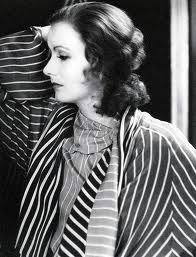
Garbo outfitted in pyjamas by Adrian in The Single Standard (1926)
Why practice we withal care almost her? "One hundred years subsequently her birth, we care because she was beautiful in a style that transcends flow taste and fashion, and her dazzler was e'er tempered past a morose emotional undertow that implied that life is short and beloved is doomed." [vi] Her eternally stylish clothing way apparently means that we still want to dress similar her in the early years of the twenty-first century: the American chainstore Nordstrom announced that their Fall 2005 line was to be named for her, apparently in a movement by her heirs to prevent any further abuse of her name or copyright infringement. [vii] The Greta Garbo Collection was made available in 22 stores that flavour merely there was no sign of the wondrous striped chinchilla or harlequin outfits that busy her every bit Leonora Moreno in Torrent (Monta Bell,1926), her beginning Hollywood movie! Not to mention her splendid array of hats.
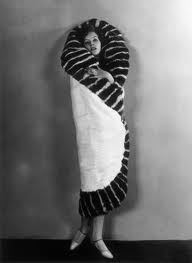
The chinchilla coat in Torrent (1926)
Garbo's continuing importance can be considered on several levels. Non simply was she schooled in Sweden and Germany – in acting and in life – she became the prototypical star for Metro-Goldwyn-Mayer, the only Hollywood studio where she would ever be employed, both in silent and audio films. She remains a pre-eminent figure of gay and feminist camp, crossdressing as witting practice, probably learned after a protracted period in 1920s Berlin with her gay mentor, Mauritz Stiller. The interplay between her private life and her perception in the public domain gave rise to many instances of estimation before, during and later on her career had long ended. Her l-twelvemonth retirement saw her pursued relentlessly past the press, and she assumed the haunted await of one resigned to her fate equally casualty, her onscreen appearance of world-weariness steadily replaced by one of strain. Garbo'due south face became an index of the twentieth century'southward media power.
What constitutes Garbo'due south cinematic signature? And who was responsible for making the public and private Garbo an icon? To establish the star as auteur – in other words to claim that she was responsible for and exercised meaning control of her ain paradigm and roles onscreen – nosotros will briefly survey some markers of authorship, equally they would be relevant to an actor: appearance, performance mode, roles, narrative structure, publicity, and iconography. We continue from Richard Dyer's admonition, that we can only truly examine the thought of the star as author by understanding the production situation under the Hollywood studio arrangement. [8] This encompasses the totality of the career – all that is publicly known almost the star and how they are perceived, and the mechanics of how that came to be. [9] Looking in detail at Flesh and the Devil (Clarence Brown, 1926) and its importance in the formation of Garbo, we might also take into business relationship the words of Patrick McGilligan – that "under certain circumstances, an actor may influence a pic as much equally a writer, manager or producer; some actors are more than influential than others; and there are certain rare few performers whose acting capabilities and screen personas are so powerful that they embody and define the very essence of their films." [10]
Silent Extra
Greta Louisa Gustafson was born in Stockholm to an impoverished family on 18 September 1905. From 1922 to 1924 she studied acting at Stockholm's Royal Dramatic Theatre and made a living working office-time every bit a model for a department store. She was shy, obsessive and had a dreadful fear of poverty, characteristics that would marker her adult life and ensure her great wealth. Her ambition had been noted early when she made her debut at the age of fifteen in the characteristic film Peter the Tramp (Erik A. Petschler, 1922). Her dramatic training, which she did not consummate, shared the aim if non the content of Stanislavsky – using physicality to attain emotional truth. This was also an edict of Mauritz Stiller, the film director credited with discovering her. Garbo was far from the ethereal beauty. She had attained her total developed height at historic period twelve and was terribly self-conscious and awkward. When watching the young Greta, Stiller institute in her movement and her wait the capacity for greatness. He fabricated the crucial realisation that when Garbo appeared tired, the audition idea her sexually angry!
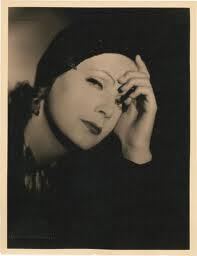
Clarence Sinclair Balderdash's 1931 portrait of the star
Garbo submitted to the svengali-like Stiller'southward desire to remould her not so much physically – that could be disguised past camerawork and costume – every bit psychologically and even spiritually. [eleven] She would come to the fore in Gösta Berlings Saga (Mauritz Stiller, 1924), complementing Lars Hanson, her future Hollywood co-star (in The Divine Woman, Victor Sjöström, 1928 and Mankind and the Devil, Clarence Brown, 1926). Stiller christened her with a suitably international moniker, 'Garbo.' She was, to all intents and purposes, his cosmos. (Perhaps it is worth remembering that his beginning product was a vampire film.) However, he merely placed her essential characteristics into a mould in which she was only too eager to fit. "She was his creation, until she began to create herself." [12] By the time she reached Hollywood, just days earlier her twentieth birthday on xv September 1925, she possessed frizzy, mousy pilus, bad teeth and was overweight. One commentator recalled '"a freak, a mess, a scarecrow. If this was what movie stars were similar in Sweden, so the sooner she returned there the ameliorate."' [xiii] She now submitted to a studio-led authorities, which she followed rigorously to the end of her days – MGM were not above introducing actresses to a nutrition of worms to accomplish the perfect figure and it is too suggested that Garbo may have had minor cosmetic surgery to thin out her nose. (Ironically, her bandage-iron dedication to self-deprivation would atomic number 82 her to wrinkle and age prematurely, helping throw latterday comeback plans into disarray.)
Hollywood: Producers
Hollywood needed to sate its want for an exotic object of lust simply initially misunderstood the type if non the essence of Garbo's entreatment. Louis B. Mayer may have discovered her at Stiller's side, but MGM's young product primary Irving Thalberg was instrumental in creating the new generation of stars, insisting on "careful story selection, appropriate co-stars and top directors… he therefore showcased his stars in pictures characterized past polish, glamour and style. To this end he provided the finest available experts in makeup, wardrobe, cinematography and art management." [14] As Thalberg saw information technology, stars were created by the audience. Director Clarence Dark-brown recalled, "At MGM we previewed our pictures three, four or five times. That allowed the producer to put his finger in the pie. The audience filled in their reactions on special cards…" [15]
Garbo's commencement ii Hollywood films had her play Hispanic seductresses; both Torrent and The Temptress (Fred Niblo, Mauritz Stiller, 1926) were based on work by the novelist Vicente Blanco Ibáñez, the source of 2 of Valentino's greatest successes (Four Horsemen of the Apocalypse, Rex Ingram, 1921 and Blood and Sand, Fred Niblo, Dorothy Arzner, 1922.) Thalberg had initially judged the function of the tormented opera star in Torrent besides ridiculous for his wife, Norma Shearer, whose career he closely guided. But on seeing the newly made-over Garbo in the role with her pilus and teeth newly straightened –he jumped from his seat and announced that she was going to be the biggest thing in movies. Critics agreed – Diverseness'due south commentator stating '"this girl has everything – looks, interim, ability and personality."' [16] Equally Sumiko Higashi puts it, "with the arrival of Greta Garbo on the Hollywood screen, the vamp metamorphosed into a truly desirable and conceivable woman." Garbo plays the Trilby-esque role of Leonora, a Spanish peasant who becomes a famous opera vocalizer in Paris, and takes the active position in a kissing scene with co-star Ricardo Cortez – a move that she would repeat to famous effect in a horizontally posed shot when teamed with John Gilbert in Flesh and the Devil. [17]
Garbo was fully enlightened of the reward of having a good producer. After a sojourn from MGM following a falling out with Mayer and a bout of ill-health, Thalberg was notably responsible for guiding the production of Camille (George Cukor,1936), in which Garbo gave what is, arguably, her finest performance. She pleaded with David O. Selznick to remain at MGM but he left to pursue his ambitions independently, taking some of her projects with him. [18]
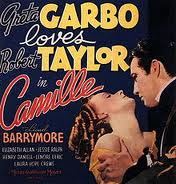
Poster for Camille (1936)
While considered unique, Garbo was still perceived to be somewhat interchangeable with that other European symbol of androgyny and unalloyed sexuality, Marlene Dietrich. Andre Sennewald saw in Mae West a welcome relief from their "sulphurous sexdramas." [xix] West herself parodied Garbo in film inside a movie, The Globe-trotting Lady in Get West Fellow (Henry Hathaway, 1936.) Both Dietrich and Garbo were directed by the stylist Richard Boleslawski in exotic melodramas – Garbo in The Painted Veil (1934) and Dietrich in The Garden of Allah (1936); the latter had been developed by Selznick for Garbo and her costar from The Painted Veil, Herbert Marshall. Still he took the projection with him from MGM and shot the film with Marshall, teaming him with Dietrich in the office originally proposed for Garbo. Blood-red Dust (Victor Fleming, 1932) was likewise developed with Garbo in listen but in fact became a star vehicle for Jean Harlow whose connection to the audience was on an altogether earthier level. [xx]
Hollywood: Directors
It is surely no blow that Garbo accomplished her offset great Hollywood part nether the direction of Clarence Chocolate-brown. He had drawn from Valentino probably the best performance of his career in The Hawkeye (1925); and the director considered Valentino and Garbo the greatest screen personalities. [21] MGM was in fact grooming Garbo to replace Valentino. Brown said of working with her, "Greta Garbo had something that nobody ever had on the screen. Nobody. I don't know whether she fifty-fifty knew she had it, but she did… [she] had something backside the eyes that yous couldn't see until you photographed it in close-up. You could see thought. If she had to expect at i person with jealousy, and some other with dear, she didn't accept to modify her expression. You could run across information technology in her eyes as she looked from 1 to the other. And nobody else has been able to do it on the screen. Garbo did information technology without the command of the English linguistic communication.
"For me, Garbo starts where they all leave off." [22] Those sentences hint at Garbo's greatest role – echoing the inner lives of her audience.

Flesh and the Devil (1926)
Garbo'southward friend and sometime lover Mercedes de Acosta said of her, "'Greta was practically never directed in a scene. She would leave on a set up and, knowing the grapheme, she would just and completely go that graphic symbol.'" [23] Garbo was always Garbo, despite the array of talented collaborators with whom she worked.
Flesh and the Devil would prove to exist an extraordinarily important film in Garbo'southward life. Her guilt over her success and Stiller'southward simultaneous fall from grace was carried with her; she took on the project, based on a novel past Herrmann Sudermann, at a time when she knew that Stiller was going to be leaving America. He urged her to try and change her style, to choose her ain wardrobe for the picture but she met with resistance from Louis B. Mayer and obeyed studio orders. She then met John Gilbert, her leading human being, which had a number of implications. Prior to this, her male co-stars had been foreign, like her. He was different: he believed in living life to the full, valiantly re-creating offscreen the romantic epitome he portrayed on film. Their meeting would prove propitious –not merely a lesson in love for Garbo simply in life and how to alive it. She commented, "'He lifts me up and carries me along with him. Information technology is non just a scene I am doing – I am living.'" [24] In short, he introduced her to the world of Hollywood glory.
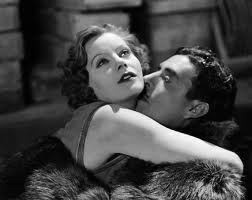
Garbo and Gilbert
The movie was a remarkable achievement in many ways. It was the showtime to play for four weeks at the Capitol picture palace in New York City. Audiences flocked to information technology, no doubt encouraged by reviews such equally the one in Film Play whose writer commented, "the story centers around a very naughty lady, scheming, unscrupulous, attracting. She is Greta Garbo who, you lot know full well, can be all that and so some. She is magnificently effective equally Felicitas, her all-time role then far. In her hands this unabashed siren becomes a genuine grapheme study, replete with low-cal and shade." [25]
The critic for The Film Spectator magazine noted Brownish'south "ability to tell a story with activity, and to etch cute scenes with which to tell information technology. The photography … is a excellent example of the loftier degree of fine art that can be reached with the camera, and Brownish was fortunate in having such an artist as William [Billy] Daniels to turn the crank. … it is one of the most satisfying to the discriminating eye that ever accept been produced in an American studio." The writer continues that Garbo demonstrates "her powers as they seldom have been revealed." [26] The fact that Garbo celebrated her xx-first altogether on the set just a week earlier filming was completed gives the lie to the idea, often mooted, that she couldn't act. Her performance is that of someone with twice her years and experience, transmitting the kind of weary eroticism and deceitfulness belonging more properly to an ageing courtesan. Ane commentator finds that Brown and Daniels together "composed what became her filmic insignia, photographically emphasising those biconvex eyebrows and high forehead, lighting to whiten her face and force out its strong masculine bone construction." [27] Sympathetic directors and cinematographers understood her strengths and smoothed out her shortcomings, creating the illusion of perfection, shooting her only in extreme shut-ups or long shots, picking up on an emotional range that simply could not exist identified in person.
Garbo's Face
To quote Gloria Swanson in ??Dusk Blvd. ?? (Billy Wilder, 1950) 'We didn't demand dialogue – we had faces.' Above all, in that location was Garbo's confront. The confront that age could not deny, despite the inevitable ravages of time on a woman who had already appeared to possess infinite globe-weariness when she was barely out of her teens. As Stiller had reported on his discovery to Svensk Filmindustri in a memorably prophetic phrase, " 'You lot get a confront similar that in front of a camera just one time in a century.'" [28]
Our perception of Garbo is largely governed by her visual impact. Non only was her motility significant, all angles and masculinity; her face controls our response to her. Biographer Barry Paris explains: "some quirk of Nature and Art created a confront, a personality, and an erotic presence unprecedented in history. Garbo was an anomaly, not a mystery. She was something to exist experienced rather than adored, but people did both." [29]
For the justifiably famous endmost shot of Queen Christina (1933), managing director Rouben Mamoulian was not to a higher place a flake of subterfuge to camouflage the Divine Ane'south imperfections. He "devised a large, ruler-shaped, glass filter strip that was clear at one end, becoming increasingly more diffused along its length. With this drinking glass filter mounted in front of the lens, as the camera moved in on Garbo, the drinking glass strip was gradually drawn through the filter holder, start with the clear stop, and catastrophe with the diffused end (shut-up), softening Garbo's facial features with more than flattering results." [30]

A Woman of Diplomacy (1926)
Garbo occupies a cinematic position where gender and sexuality are in tension – her undoubted eroticism, so powerfully signified in the looks exchanged with John Gilbert in Flesh and the Devil, literally leaves the audition gasping for air. Her presence in the film is overwhelming, dominating even those scenes in which she does not announced. This is primarily because of the style we are conditioned in how to look at her through the optics of John Gilbert, who is photographed every bit though dumbstruck on seeing her character, Felicitas, for the first fourth dimension. We come across her as she is seen by him: with a mixture of awe, lust and disbelief. This play on their interchange of looks and mutual animalism would be continued in the later picture show, A Woman of Affairs (Clarence Brown, 1929). Equally Diana Merrick Furness, based on the protagonist of Michael Arlen'south novel The Green Hat, of which this is an uncredited adaptation, and paired again opposite John Gilbert, she is stronger than the male gaze and – we might say– she ultimately defeats information technology. And in reality, she would overshadow each of her male co-stars, one by i.
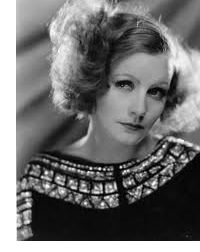
Torrent (1926)
Billy Daniels photographed her in nineteen of her films. His relationship with her was possibly more significant than that of any managing director. In one-time thespian Tom Tryon'due south roman à clef Fedora (Billy Wilder, 1978), the subject of which is the impossibility of lasting beauty, it is appropriate that Garbo the vamp, is personified equally the vampire-like star in literal reversal of the Elisabeth Bathory myth. Baton Daniels becomes 'Walter Male monarch,' –the King to Hollywood'south Queen– who "discovered new things in Fedora'due south face that as she grew to increasing maturity but intrigued her viewers more." [31] Her comeback is non due to miraculous Swiss cosmetic surgery only rather the life that she has sucked from her own creation, her lookalike daughter, Ophelie. (Tryon could not resist suggesting that Garbo reproduced, although there is absolutely no testify that this was in fact the example.) Fedora is a lined and anile crone, living off and with long-suffering friends, her complicated love life equanimous of the irregular triangulation that involves husbands and wives. In real life, Garbo had compromised her friend and neighbour the designer Valentina Schlee and was with George Schlee, a Russian lawyer, when he died. She was banned from his funeral. Tryon blends fact and fable to provide a lamentable portrait of the haunted recluse who "… is the near selfish of creatures," a fact with which her existent long-term lovers and sometime friends, Cecil Beaton and Mercedes de Acosta concurred. [32]
Off-screen Garbo was regularly photographed wearing men's dress, the antithesis of the couture deco look by Adrian and so carefully adorning her onscreen characters, and proving a troubling counterpart to her image as man-eating star. [33] As a old model, Garbo was acutely aware of the power of the image. She worked closely with Adrian in each of her films to draw attention to her greatest characteristic – her confront – by wearing an extraordinary choice of hats, putting her feel every bit milliner's assistant to good use and informing fashion trends in the process. [34]
Garbo's Vocalisation
From her days at drama school, Garbo's vocalisation was deemed problematic. Even Stiller was heard to say, "Thank goodness she doesn't accept to speak." [35] MGM were fearful that the effect of her loftier-pitched voice would ruin her career. They continued to star her in silents until Eugene O'Neill'southward Anna Christie (Clarence Chocolate-brown, 1929). [36] Her first talkie was a huge success – her thick throaty pronunciation deemed a please. The transition to sound did not destroy her career equally it had many others. She consciously effected a change in her voice earlier her next production and to any Swedish viewers over the coming years it was obvious that she was imitating not 1 merely two actresses of note; Gerda Lundeqevist, her co-star in Gösta Berlings Saga –and whose offscreen persona of terminal weariness, suggestive of sophistication, she adopted as part of her onscreen tics; and Naima Wifstrand, the Laplander extra, whose husky accent Garbo learned to imitate when on a trip to Sweden in 1928. In Rachel Gallagher'due south The Girl Who Loved Garbo, the protagonist is told that Garbo was "a obviously girl, big-boned, clumsy… [who] patterned herself afterwards" Lillian Gish. [37] Above all, friends noted that Garbo was a superb mimic. Alexander Walker argues that she was not the writer of these characteristics, merely their vehicle of expression, which leads to the decision that in an authorial sense, hers was simply a single vocalisation amongst many in terms of the construction of her star paradigm by MGM. [38] However, that she incorporated these aspects every bit part of a consciously articulated persona that would lend itself to certain successful screen types and narrative representation, is an equally valid notion and 1 that exhibits the degree of ownership which she could claim over her prototype.
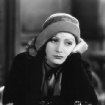
Garbo in Anna Christie (1930)
Flesh and the Devil is noteworthy on a narrative level for its continuing association of Garbo with the function of temptress. Her graphic symbol is deceitful, selfish, avaricious, manipulative and without conscience; the bored married woman and skilled seductress who causes her married man's death and so disrupts a lifelong friendship between two male soul-mates, is duly punished for her arrogance. This would prove a template for most of her future films at MGM as she embodied the 'tragic shady lady.' The 'tragic' component would in office be influenced by the censorious Production Code, which advocated the presence of "compensating moral value" in any narrative. So information technology was that sexual transgression would be fatalistically punished with either social condemnation or a hideous expiry as moral coda. [39] To paraphrase Jeanine Basinger, she died for the audience'southward sins. [40] Positioned in melodrama, a textual form foregrounding the contradictions betwixt desire and duty, expressing ideas of romance and the female person point of view, her image was copper-attached in romantic sacrifice. [41] Every bit one reviewer commented on seeing Queen Christina, "what would a Garbo pic be without passionate love?" [42] Garbo incarnates the fallen adult female, a type not exclusive to Hollywood, but one conveniently on standby in a troubled social era where neither Madonna nor whore is, by themselves, entirely adequate. David Thomson calls her roles in these films "new versions of prostitution fantasies attuned to the mass media." [43] Her position was made more complex by visual innuendo, notably in the Communion scene in Flesh and the Devil. Not just does it communicate desire to the audience it too suggests sexual commingling at the level of the sacred. Every bit Garbo biographer Barry Paris notes, she was "neither virgin, vamp, nor flapper, but an entirely new female animal." [44] Garbo'due south appearance, as noted by Lucy Fischer, seemed to constitute the thrilling if sometimes frightening onslaught of modernity itself. [45]
The production of Flesh and the Devil wasn't just notable for introducing Garbo to Gilbert (which gave rising to a much overstated 'legendary' Hollywood affair) – Gilbert then introduced her to his director, Harry Edington, a man who would assume huge significance in the arranging of her career and finances. (She retired a very rich adult female, principally from her investments in holding, rumoured to include a large role of the exclusive Rodeo Drive.) Garbo used her position to integrate performance and production past forging a unique bargain with MGM, demanding a salary increment from $600 to $5,000 per calendar week. She went home and and then spent time on suspension until the studio saw the light – and the box role returns from Flesh and the Devil. She received a dorsum-dated increase to $2,000 per week with built-in options and holidays. In that location are rumours that she may accept had a surreptitious deal to turn a profit-share. She controlled her textile and her managing director and even dictated filming dates, within reason. [46] Nether Edington's sway, Garbo ceased all cheapening publicity, in a bid to make even more exclusive her greatest asset –her face– and gradually began to isolate herself from the earth, with her interpreter and advisor, Sven-Hugo Borg, urging her onwards in her quest for legendary mystery. [47] What Garbo didn't know was that Edington was in the pay of MGM, suggesting that she wasn't in as much control of her image every bit she idea. [48]
The Writers
MGM was a especially good studio for women writers and Garbo worked with Dorothy Farnum, Bess Meredyth, Josephine Lovett, Zoë Akins, Salka Viertel and Frances Marion –who said of her, "It was ever fascinating to watch Garbo; her economy of gesture, abiding changing of moods revealed by her luminous optics that never played the little physical tricks used by so many actresses." [49] Garbo's qualities were such that a modest number of screenwriters was gradually preferred to tailor roles to her ideal specifications. I of these was Benjamin Glazer who scripted both Mankind and the Devil and Mata Hari (George Fitzmaurice,1931). Another was Garbo's close friend Salka Viertel, (Queen Christina, The Painted Veil, Anna Karenina, Brown, 1935, Conquest, Ii-Faced Woman). She devised the role of Queen Christina for Garbo; and also that of Napoleon's muse, Marie Walewska, in Conquest (Chocolate-brown, Gustav Machatý, 1937), the woman who had borne his illegitimate child. Viertel attempted a screenplay on the subject of Marie Curie with Garbo's approval, but this was ultimately shelved past the studio. Viertel was seen as a 'Garbo specialist,' and when, in the wake of the stunning success of Ninotchka, MGM sought a sequel, Garbo and Viertel preferred to arrange a Scott O'Dell novel. The studio wanted a film that would capitalise on Garbo's affair with Leopold Stokowski, Song of Russia, Garbo turned it downward. The film that she made was Ii-Faced Adult female (George Cukor, 1941), a troubling production which was castigated past the Legion of Decency and suffered in the wake of Pearl Harbour. The country was at war and information technology seemed nobody wanted to run into Garbo express joy. Eventually Viertel ended her time with MGM, weary of Louis B. Mayer'due south bullying. [50] She had masterminded Garbo's existential persona and distancing from the crowd, specialising in literary heroines who diameter no relation to the gimmicky world, a space which Garbo plant increasingly difficult to occupy.
The Hollywood Meta-narrative
Garbo's role in Hollywood's meta-narrative – the bigger picture, if you adopt – was on several levels. The parallels between her moving picture roles and her off-screen life are many, ranging from her comical interpretation of English, a language she would never fully master, and which would eventually be used to bang-up outcome in Ninotchka; to her many unsatisfying relationships; and her well-known desire "to be lone," a line knowingly introduced to the dialogue of One thousand Hotel (Edmund Goulding,1932), the outset ensemble star drama, masterminded by Thalberg, in which Garbo was the only consideration for the role of Grusinskaya, the elusive Russian ballerina. When Garbo jilted John Gilbert – off-screen! – he married Ina Claire on the rebound – Garbo and Claire would act out a memorable confront-off onscreen in Ninotchka over a decade later on, when Gilbert was already dead five years. When she acted the deathbed scene in Camille, few knew that she was in real life recovering from a life-threatening illness. Whether she came to believe her own publicity or her writers created roles around her private character or her pre-existing screen roles –is moot: both notions are demonstrably truthful. Still much the private and the public may have been conflated –and how much of her screen persona may have derived from her observation of other actresses– does non lessen her bear upon equally author of her onscreen persona. In other words, the fact that Garbo may take borrowed from other people in order to create a screen character that was consequent and recognisable from flick to film does not make her any less meaningful in the authoring of her performances and her iconic status.
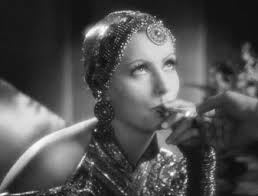
Masquerading in Mata Hari (1931)
Garbo's life-long contempt for publicity and the people who purveyed information technology stemmed from her earliest days at MGM when she was badly handled – an experience that she described as "a living expiry." David O. Selznick recalled in a memo dated 7 February 1945: "she was handled past the Publicity Department at Metro exactly equally they handled any new stock daughter that had been signed up. When the day came that she became a slap-up star, she refused whatever kind of cooperation because she had lost all faith and conviction, and properly so, in the judgment and taste of the Publicity Department." [51] She insisted on being left lone on picture sets, even having screens put around her to protect her from onlookers. It led to occasional savaging by the press because she had power without the concomitant visibility. [52] Walker says that "no star has so convincingly, tenaciously, or continuously exhibited her forcefulness of will in protecting her essential self, even at the risk of a unique movie career." [53] (In a 2005 edition of The Times an eminent physician diagnosed her with a course of social phobia!) [54]
Garbo's Function in the Wider Globe
Xl-five years subsequently she had last appeared on movie theatre screens the motion picture championship Garbo Talks (Sidney Lumet, 1984) needed no caption, such was the ongoing ability of her name and image. The story centres on a dying woman's terminal wish to meet her Nordic idol. That Garbo was played by the very visible (and exact) New York songwriter and scenarist Betty Comden compounds the film's ironies.
Garbo continues to characteristic every bit an important figure in the parallel world of the imaginary feminine. As Richard Dyer reminds us that "the star phenomenon consists of everything that is publicly available about stars," [55] the Garbo upshot can be seen at piece of work in a number of contemporary novels in which her on- and off-screen persona is cited equally instance for the heroines. What Alexander Walker calls "her fugitive and enduring mystery" still casts a spell on female writers attempting to proper name their heroines' feelings and recapture their essential selves. [56] Garbo's position in the imagination is negotiated at ii levels – her love life, off- and onscreen, and her business relationship with MGM. In these books the heroine ofttimes asks herself, What would Garbo practise in my situation?
These fictional texts, based in both the facts and rumours circling virtually Garbo, reassert the ongoing, dynamic relationship between star and audience, the private and the public spheres conjoined into a larger meta-narrative, both existent and unreal.
'"Everybody saw Garbo. She dressed upwardly to exist recognized. Here comes Garbo pretending non to be Garbo,'" says one of the characters in Garbo Laughs. [57] When Tom Tryon'southward Fedora is finally establish out, she admits the burden to the narrator: "People always like people who accept faces – equally if a nose could make your fortune. They similar people whose names are in electric lights, never thinking the bulbs may accident out at any fourth dimension. Merely the worst was not to exist able to go out into the street like every body else. People always looking, post-obit, wanting to know – always to know." [58]
One of those people was author Jane Ellen Wayne, who recalls spotting Garbo on a New York street in the nineteen eighties, when, she comments, "I couldn't help but discover a woman in a floppy lid, shabby raincoat, walking shoes and galoshes like mine. In that getup she was probably someone's housekeeper, but there was something oddly familiar well-nigh her. When she stopped to look in a store window, I did besides. And in that location it was – the reflection of Greta Garbo. I didn't know what to do, but I knew what not to exercise and that was stare at her or, God forbid, offer a 'How-do-you-do, Miss 1000.'
"She walked on and and then did I. She stopped at a kerb for a red light and I looked and saw her profile – that famous magnificent profile that was breathtaking despite the damp droopy lid." [59] The central phrase in Wayne'south account is 'the reflection of Greta Garbo.' Her paradoxical nature led her to proclaim her desire to flee the madding crowd yet to socialise and holiday with the world'southward most famous people in the most desirable and luxurious resorts to be had afterwards her unintentional retirement. Perhaps she was still seeking the ideal role.
Observers testify that Garbo behaved utterly differently earlier and after shooting scenes. What she offered as performance therefore was non entirely her essential cocky. The magical transmogrification took place in the chemical reaction that was the fixing of her image onto motion-picture show. Garbo projected and reflected through the camera prism that had many masters, including Garbo herself. She was the perfect mirror for her audience's feelings. Her instincts were entirely cinematic; her unwitting retirement an inadvertent investment in legend.

Queen Christina (1933)
By all accounts, there was really goose egg special nearly Greta Garbo in person: she existed on the screen in a way she simply could not contemplate in life. So, yes, Garbo was an auteur, just, to rephrase Bazin, what of? If as, one commentator suggests, "screen acting has always been most being oneself," perhaps the selves she exhibited onscreen were a serial of variations on her essential self. [60] And the effort to protect her privacy may have simply exhausted her desire to act once more. To answer Patrick McGilligan, Garbo can be deemed to take had crucial influence (if not the last say) over the films in which she starred and is undoubtedly one of those "rare few performers whose acting capabilities and screen personas are and so powerful that they embody and define the very essence of their films." [61]
While an analysis of the arrangement that produced Garbo the star yields several possible authors – collective, corporate, multiple, or fifty-fifty the singular figure of Garbo hersellf in her mastery of internal authorship; timing, planning, historical circumstance and the ambition and artful choices of all involved, combine to leave us finally with something ineffable, what David Thomson calls "a mysterious truth… she was photographed. She was all in the argent." [62]
Endnotes
1 'The l Greatest Movies Stars of All Fourth dimension', Premiere, April 2005: 72.
2 Jeanine Basinger, 1993: 166
three Basinger,op.cit., 161.
four Alexander Walker,1980:180
v Roland Barthes, 1973: 56-57
6 Eyman, '31 August 2005.
7 Ozzard, 29 June 2005, accessed online.
8 Dyer, 1998:152
9 Dyer, in Stam and Miller (eds.),2000: 604.
10 McGilligan, 1975: 199.
11 Walker, op.cit., 26.
12 Gallagher, 1990: 56.
xiii Phillips (ed.),1978: 88.
fourteen Samuel Marx, 'Hollywood's Male child Wonder: Irving Thalberg,' in Ann Lloyd, ed., 1983: 49.
15 Kevin Brownlow, 1973: 12
16 Phillips, op.cit., 89.
17 Sumiko Higashi 1978:75.
18 Behlmer, op.cit., 97.
19 Andre Sennewald, 'Lines for a Mae West Scrapbook,' New York Times, 30 September 1934 Sec. 9 p. 4, quoted in Pamela Robertson, 1996: 39
20 Miller, op.cit., 86-87.
21 Brownlow, op.cit., 167.
22 Brownlow op.cit., 169.
23 Mercedes de Acosta, 1960, HERE LIES THE HEART (London: André Deutsch, 232) quoted in Walker, op.cit., twenty.
24 Walker, op.cit., 59.
25 'Flesh and the Devil,' Picture Play' (April 1927), quoted on Silents are Gilded
26 'Clarence Brown Scores a Triumph,' (1927) The Flick Spectator, five February: two-3.
27 Ferdinand Alexi Hilenski, 'Hollywood Yin: Clarence Brown's Feminine Universe,' College of Liberal Arts, Knoxville, Tennessee: eleven.
28 Walker, op.cit., 22.
29 Paris, 1995: 553.
30 IMDB
31 Tryon, 1976: 79; 39.
32 Cecil Beaton, 1976; and Hugo Vickers, 1994.
33 "In reel life, Garbo dressed like a mistress; in real life, like a available." Rachel Gallagher, 1990: 160.
34 Worsley, 2002: 75.
35 Phillips(ed.), op.cit., 89.
36 Brownlow, op.cit., 664.
37 Gallagher, op.cit.,53.
38 Walker, 1968: 99-117.
39 Miller, 1994: 86-87.
40 Basinger, op.cit.,173.
41 Tasker, 1998: 141.
42 James Shelley Hamilton, 'Ii Queens,' in Hochman (ed.) 1982: 182.
43 Thomson, 2004: 182.
44 Paris, 1990: 117.
45 Lucy Fischer, 'Greta Garbo and Silent Cinema: The Actress as Fine art Deco Icon,' in Bean and Negra (eds.) 2002: 493. See also Thomson, 2004.
46 Thomson, op.cit.,182-183.
47 Walker, op.cit., 68.
48 *Ibid.
*Garbo biographer Barry Paris suggests information technology was also a ploy to keep her lesbianism from journalists.
49 Tim Lussier, 'Greta Garbo The Official Dream Princess, Silents are Gilded, accessed 12 August 2005.
l Viertel,1969.
51 Behlmer, (ed.), op.cit., 357.
52 Walker, 1980: 124.
53 Ibid.
54 Stuttaford, 2005: 14.
55 Dyer in Stam and Miller, 2000 (eds.): 604.
56 Walker, op.cit., 12. The novels are GARBO LAUGHS, 2004 by Elizabeth Hay and THE Girl WHO LOVED GARBO, 1990 past Rachel Gallagher.
57 Hay, op.cit., 226-227.
58 Tryon, op.cit., 95.
59 Wayne, 2005: 16.
threescore Lodge, 1985: 94.
61 McGilligan, ibid.
62 Thomson, 1994: 276.
BIBLIOGRAPHY
Books
Barthes, Roland. (1973) MYTHOLOGIES. St Albans, Herts.: Granada Publishing.
Basinger, Jeanine (1993). A Woman'S VIEW: How Hollywood Spoke to Women 1930-1960. London: Chatto and Windus.
Bean, Jennifer Grand. and Negra, Diane (2002). A FEMINIST READER IN EARLY CINEMA. Durham & London: Duke University Press.
Beaton, Cecil (1976). THE RESTLESS YEARS: Diaries 1955-63. London: Weidenfeld and Nicolson.
Rudy Behlmer (ed.) (1972) MEMO FROM DAVID O. SELZNICK. New York: The Viking Press.
Brownlow, Kevin (1973). THE PARADE'Due south GONE BY. London: Abacus.
Dyer, Richard (1998). STARS. London: British Film Establish.
Friedrich, Otto (1986). CITY OF NETS A Portrait of Hollywood in the 1940s. Berkeley and Los Angeles: Academy of California.
Gallagher, Rachel (1990). THE GIRL WHO LOVED GARBO. New York:Donald J. Fine, Inc.
Goodman, Ezra (1961) 50 YEAR DECLINE AND FALL OF HOLLYWOOD. New York: Simon & Schuster.
Hay, Elizabeth (2004). GARBO LAUGHS. London: Constable & Robinson, Ltd.
Higashi, Sumiko (1978). VIRGINS, VAMPS AND FLAPPERS: The American Silent Movie Heroine (Monographs in Women'south Studies) Eden Press Women's Publishing.
Hochman, Stanley (ed.) (1982) FROM QUASIMODO TO SCARLETT O'HARA: A National Lath of Review Anthology 1920-1940. (New York: Frederick Ungar Publishing Co.)
Lloyd, Ann (ed.) (1983) MOVIES OF THE THIRTIES. London: Orbis Publishing.
Lodge, Jack (1985). HOLLYWOOD 1930s. London: Multimedia Publications
McGilligan, Patrick (1975). CAGNEY: THE Histrion Equally AUTEUR. Cranbury, New Bailiwick of jersey: A.S.Barnes & Co.,Inc.
Mast, Gerald, Marshall Cohen and Leo Braudy (1992) FILM THEORY AND CRITICISM Introductory Readings. (fourth edition) New York & Oxford: Oxford University Press.
Miller, Frank (1994). CENSORED HOLLYWOOD: Sex activity, Sin & Violence on Screen. Atlanta: Turner Publishing, Inc.
Paris, Barry (1990). GARBO. New York: Alfred A.Knopf.
Phillips, Perrott (1978). OUT OF THIS Earth, Book 5. London: Phoebus Publishing.
Robertson, Pamela (1996). GUILTY PLEASURES Feminist Military camp from Mae West to Madonna. Durham and London: Duke University Press.
Server, Lee. WORDS Become PICTURES. New Jersey: Metuchen Press
Sklar, Robert (1994). Motion-picture show-Made AMERICA A Cultural History of American Movies. New York: Vintage Books.
Schatz, Thomas (1998). The Genius of the System. London: Faber & Faber.
Sinyard, Neil (1990). SILENT MOVIES. London: Bison Books Ltd.)
Stam, Robert and Toby Miller (2000) FILM AND THEORY: An Anthology. Malden, Massachusetts: Blackwell Publishers, Inc.
Tasker, Yvonne (1998). WORKING GIRLS: Gender and Sexuality in Popular Cinema. London and New York: Routledge
Thomson, David (1994). A BIOGRAPHICAL Lexicon OF FILM. London: André Deutsch
________ (2004) THE WHOLE EQUATION OF PICTURES. New York: Alfred A.Knopf
Tryon, Tom (1976). CROWNED HEADS. London: Coronet
Editors of Multifariousness (1993) Variety HISTORY OF Evidence Concern. London: Hamlyn
Vickers, Hugo (1994) LOVING GARBO. London: Random House
Viertel, Salka.(1969) THE KINDNESS OF STRANGERS. New York: Holt Rinehart Winston
Walker, Alexander (1980). GARBO: A Portrait. London: Weidenfeld and Nicolson
________ (1968); SEX IN THE MOVIES. London: Penguin
Worsley, Harriet (2002). CLASSICS OF FASHION. London: The Brown Reference Group
Journal Articles
Crow, Bryan, 'The Cinematic & the Melodramatic in A Adult female OF Affairs,' Wide Angle, Vol. 4,No.2
Eyman, Scott (2005)'The Erotic Glow of Greta Garbo,' The Palm Beach Post, 31 August.
Hilenski, Ferdinand Alexi, 'Hollywood Yin: Clarence Brown'southward Feminine Universe,' College of Liberal Arts, 226 Ayres Hall, UT Campus, Knoxville, Tennessee TN 37916. (Consulted September 2005)
Newspaper Manufactures
Stuttaford, Dr Thomas (2005) 'I Want to be Lonely: The People Who Deed Like Greta Garbo,' times2/Wellness, The Times, 12 September:14.
Wayne, Jane Ellen (2005) 'I Vant to Buy Some Beans,'Screen, T2, The Times, 1 September: xvi.
Magazine Articles
'Clarence Brown Scores a Triumph,' (1927) The Film Spectator , 5 February: ii-3.
'Flesh and the Devil,' (1927) Picture Play (April)
'The 50 Greatest Movies Stars of All Time,' Premiere, Apr 2005: 72.
'Mankind and the Devil,' (1927) Diversity, 12 January.
Ozzard, Janet (2005) "'I Want to be a Line': Nordstrom Gets Garbo Proper noun for Designer Apparel," Women'due south Article of clothing Daily, 29 June 2005, accessed online 1 August 2005.
Online References
Silents are Aureate (consulted 5 August 2005)
The Golden Years (consulted viii Baronial 2005)
Copyright Citations
All images the property of MGM Studios.
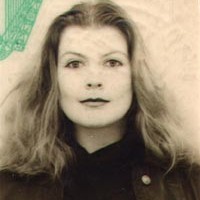
0 Response to "Decades of Fashion Harriet Worsley Torrent"
Post a Comment